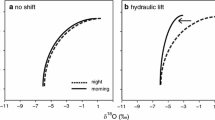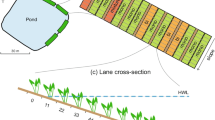Abstract
We tested the hypothesis that higher temporal variability in water supply will promote higher species richness of germinating and surviving seedlings using assemblages of 70 species of herbaceous plants from limestone pavement habitats. In a two-factor greenhouse experiment, doubling the total volume of water added led to greater germination (measured as number of germinated seeds and species) and establishment (survival and biomass) but the effects of temporal variability depended on the response variable considered. Low pulse frequencies of water addition with total volume added held constant resulted in greater temporal variability in soil moisture concentration that in turn promoted higher density and richness of germinated seedlings. Low pulse frequencies caused an eight-fold greater mortality in the low total volume treatment and biomass production to decline by one-third in the high total volume treatment. The effects of increasing temporal variability in water supply during recruitment stages can thus be opposite on different components of plant fitness and may also depend on total resource quantity. While greater species richness in more temporally variable soil moisture conditions was attributable to sampling effects rather than species-specific responses to the water treatments, species relative abundances did vary significantly with temporal variability. Changes in the amplitude or frequency of resource fluctuations may alter recruitment patterns, and could have severe and relatively rapid effects on community structure in unproductive ecosystems.



Similar content being viewed by others
References
Belcher JW, Keddy PA, Catling PM (1992) Alvar vegetation in Canada: a multivariate description at two scales. Can J Bot 70:1279–1291
Bliss SA, Zedler PH (1998) The germination process in vernal pools: sensitivity to environmental conditions and effects on community structure. Oecologia 113:67–73
Booth BD, Larson DW (1999) Impact of language, history, and choice of system on the study of assembly rules. In: Weiher E, Keddy K (eds) Ecological assembly rules: perspectives, advances, retreats. Cambridge University Press, Cambridge, pp 206–229
Campbell BD, Grime JP (1989) A comparative study of plant responsiveness to the duration of episodes of mineral nutrient enrichment. New Phytol 112:261–267
Chesson P (2000) Mechanisms of maintenance of species diversity. Annu Rev Ecol Syst 31:343–366
Davis MA, Grime JP, Thompson K (2000) Fluctuating resources in plant communities: a general theory of invasibility. J Ecol 88:528–534
Daws MI, Burslem D, Crabtree LM, Kirkman P, Mullins CE, Dalling JW (2002) Differences in seed germination responses may promote coexistence of four sympatric Piper species. Funct Ecol 16:258–267
Dodd GL, Donovan LA (1999) Water potential and ionic effects on germination and seedling growth of two cold desert shrubs. Am J Bot 86:1146–1153
Estabrook GF (1998) DIVDEN. Windows 95 edition. University of Michigan, Ann Arbor
Evans CE, Etherington JR (1990) The effect of soil water potential on seed germination of some British plants. New Phytol 115:539–548
Garcia-Huidobro J, Monteith JL, Squire GR (1982) Time, temperature and germination of Pearl Millet. J Exp Bot 33:297–302
Goldberg DE (1994) Influence of competition at the community level: an experimental version of the null models approach. Ecology 75:1503–1506
Goldberg DE, Estabrook GF (1998) Separating the effects of number of individuals sampled and competition on species diversity: and experimental and analytic approach. J Ecol 86:983–988
Goldberg D, Novoplansky A (1997) On the relative importance of competition in unproductive environments. J Ecol 85:409–418
Green RH (1993) Relating two sets of variables in environmental studies. In: Patil GP, Rao CR (eds) Multivariate environmental statistics. North-Holland, Amsterdam, pp 149–163
Grubb PJ (1977) The maintenance of species richness in plant communities: the importance of the regeneration niche. Biol Rev 52:107–145
Hedges LV, Gurevitch J, Curtis PS (1999) The meta-analysis of response ratios in experimental ecology. Ecology 80:1150–1156
Huston M (1979) A general hypothesis of species diversity. Am Nat 113:81–101
Kenkel NC, Derksen DA, Thomas AG, Watson PR (2002) Multivariate analysis in weed science research. Weed Sci 50:281–292
Lundholm JT (2003) Environmental heterogeneity in time and space: effects on plant species diversity in an unproductive ecosystem. Dissertation. University of Guelph, Guelph, Ontario, Canada
Lundholm JT, Larson DW (2003) Relationships between spatial environmental heterogeneity and plant species diversity on a limestone pavement. Ecography 26:715–722
Murdoch AJ, Roberts EH, Goedert CO (1989) A model for germination responses to alternating temperatures. Ann Bot 63:97–111
Newmaster SG, Lehala A, Uhlig PWC, McMurray S, Oldham MJ (1998) Ontario plant list. Ontario Forest Research Institute, Sault Ste. Marie, Ontario, Canada
Noe GB (2002) Temporal variability matters: effects of constant vs. varying moisture and salinity on germination. Ecol Monogr 72:427–443
Novoplansky A, Goldberg DE (2001) Effects of water pulsing on individual performance and competitive hierarchies in plants. J Veg Sci 12:199–208
Oomes MJM, Elberse WT (1976) Germination of six grassland herbs in microsites with different water contents. J Ecol 64:745–755
Raynal DJ, Bazzaz FA (1973) Establishment of early successional plant populations on forest and prairie soil. Ecology 54:1335–1341
SAS (1989) SAS v. 6.12. Cary, N.C.
Silvertown J, Dodd ME, Gowing DJG, Mountford JO (1999) Hydrologically defined niches reveal a basis for species richness in plant communities. Nature 400:61–63
Stark KE, Lundholm JT, Larson DW (2003) Relationships between seed banks and spatial heterogeneity of North American alvar vegetation. J Veg Sci 14:205–212
Stephenson SN, Herendeen PS (1986) Short-term drought effects on the alvar communities of Drummond Island, Michigan. Mich Bot 25:16–27
Stockey A, Hunt R (1992) Fluctuating water conditions identify niches for germination in Alisma plantago-aquatica. Acta Oecol 13:227–229
Tilman D, Pacala S (1993) The maintenance of species richness in plant communities. In: Ricklefs RE, Schluter D (eds) Species diversity in ecological communities: historical and geographical perspectives. University of Chicago Press, Chicago, pp 13–25
Vincent EM, Cavers PB (1979) The effects of wetting and drying on the subsequent germination of Rumex crispus. Can J Bot 56:2207–2217
Acknowledgements
We thank Peter Kotanen, Sean Blaney, Margy De Gruchy, Cherie-Lee Fietsch, Pete Clarke, Sabine Girard, Sylvain Thévenet, Loui Polic and Lianne Yoshida for collecting seeds. John Gerrath, Suzanne Waters, Michael Pavone, Brooke Thiessen, Stacey Koebel, Pete Kelly, and Kevin Stevens assisted in the greenhouse. We thank two anonymous reviewers for critical comments on the manuscript. We are indebted to Uta Matthes, Deborah Goldberg and Beren Robinson for statistical advice and NSERC and Parks Canada for financial assistance.
Author information
Authors and Affiliations
Corresponding author
Electronic Supplementary Material
Rights and permissions
About this article
Cite this article
Lundholm, J.T., Larson, D.W. Experimental separation of resource quantity from temporal variability: seedling responses to water pulses. Oecologia 141, 346–352 (2004). https://doi.org/10.1007/s00442-003-1454-6
Received:
Accepted:
Published:
Issue Date:
DOI: https://doi.org/10.1007/s00442-003-1454-6




